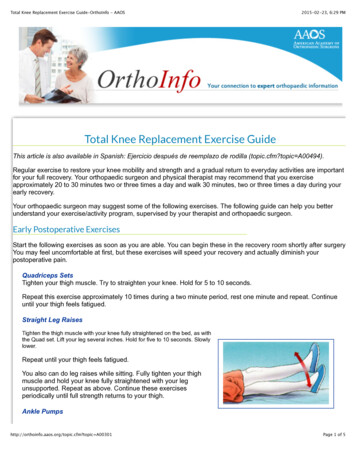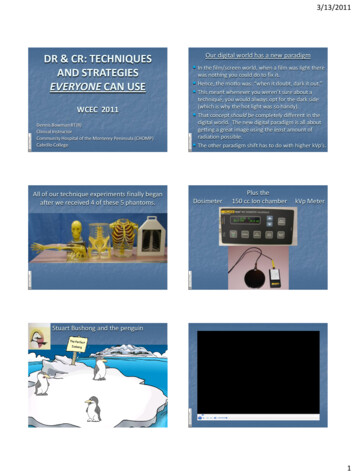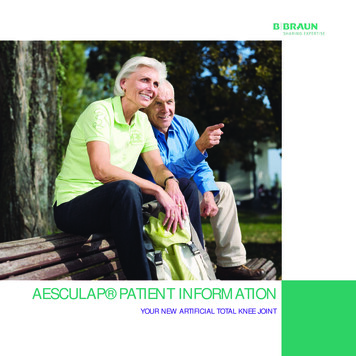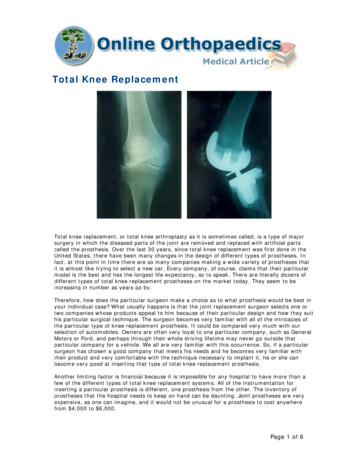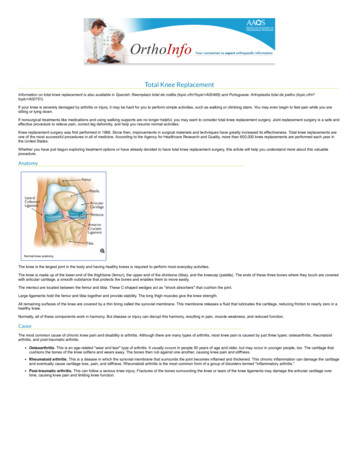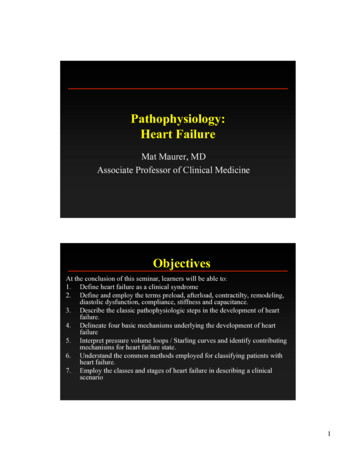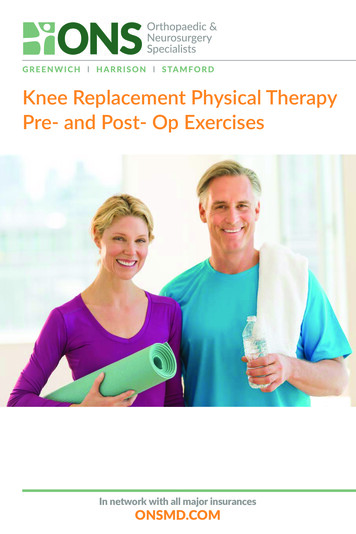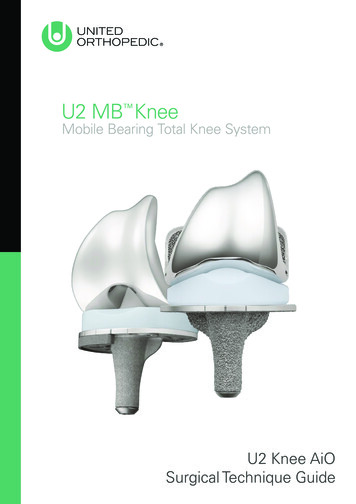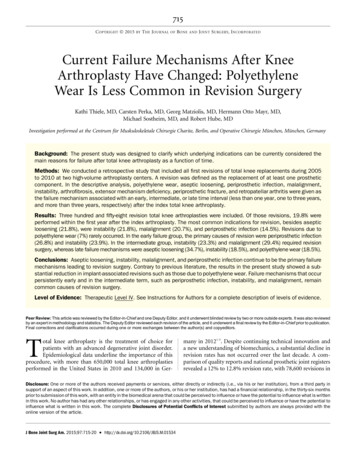
Transcription
715C OPYRIGHT Ó 2015BYT HE J OURNALOFB ONEAND J OINTS URGERY, I NCORPORATEDCurrent Failure Mechanisms After KneeArthroplasty Have Changed: PolyethyleneWear Is Less Common in Revision SurgeryKathi Thiele, MD, Carsten Perka, MD, Georg Matziolis, MD, Hermann Otto Mayr, MD,Michael Sostheim, MD, and Robert Hube, MDInvestigation performed at the Centrum für Muskuloskeletale Chirurgie Charite, Berlin, and Operative Chirurgie München, München, GermanyBackground: The present study was designed to clarify which underlying indications can be currently considered themain reasons for failure after total knee arthroplasty as a function of time.Methods: We conducted a retrospective study that included all first revisions of total knee replacements during 2005to 2010 at two high-volume arthroplasty centers. A revision was defined as the replacement of at least one prostheticcomponent. In the descriptive analysis, polyethylene wear, aseptic loosening, periprosthetic infection, malalignment,instability, arthrofibrosis, extensor mechanism deficiency, periprosthetic fracture, and retropatellar arthritis were given asthe failure mechanism associated with an early, intermediate, or late time interval (less than one year, one to three years,and more than three years, respectively) after the index total knee arthroplasty.Results: Three hundred and fifty-eight revision total knee arthroplasties were included. Of those revisions, 19.8% wereperformed within the first year after the index arthroplasty. The most common indications for revision, besides asepticloosening (21.8%), were instability (21.8%), malalignment (20.7%), and periprosthetic infection (14.5%). Revisions due topolyethylene wear (7%) rarely occurred. In the early failure group, the primary causes of revision were periprosthetic infection(26.8%) and instability (23.9%). In the intermediate group, instability (23.3%) and malalignment (29.4%) required revisionsurgery, whereas late failure mechanisms were aseptic loosening (34.7%), instability (18.5%), and polyethylene wear (18.5%).Conclusions: Aseptic loosening, instability, malalignment, and periprosthetic infection continue to be the primary failuremechanisms leading to revision surgery. Contrary to previous literature, the results in the present study showed a substantial reduction in implant-associated revisions such as those due to polyethylene wear. Failure mechanisms that occurpersistently early and in the intermediate term, such as periprosthetic infection, instability, and malalignment, remaincommon causes of revision surgery.Level of Evidence: Therapeutic Level IV. See Instructions for Authors for a complete description of levels of evidence.Peer Review: This article was reviewed by the Editor-in-Chief and one Deputy Editor, and it underwent blinded review by two or more outside experts. It was also reviewedby an expert in methodology and statistics. The Deputy Editor reviewed each revision of the article, and it underwent a final review by the Editor-in-Chief prior to publication.Final corrections and clarifications occurred during one or more exchanges between the author(s) and copyeditors.Total knee arthroplasty is the treatment of choice forpatients with an advanced degenerative joint disorder.Epidemiological data underline the importance of thisprocedure, with more than 650,000 total knee arthroplastiesperformed in the United States in 2010 and 134,000 in Ger-many in 20121-3. Despite continuing technical innovation anda new understanding of biomechanics, a substantial decline inrevision rates has not occurred over the last decade. A comparison of quality reports and national prosthetic joint registersrevealed a 12% to 12.8% revision rate, with 78,600 revisions inDisclosure: One or more of the authors received payments or services, either directly or indirectly (i.e., via his or her institution), from a third party insupport of an aspect of this work. In addition, one or more of the authors, or his or her institution, has had a financial relationship, in the thirty-six monthsprior to submission of this work, with an entity in the biomedical arena that could be perceived to influence or have the potential to influence what is writtenin this work. No author has had any other relationships, or has engaged in any other activities, that could be perceived to influence or have the potential toinfluence what is written in this work. The complete Disclosures of Potential Conflicts of Interest submitted by authors are always provided with theonline version of the article.J Bone Joint Surg Am. 534
716TH E JO U R NA L O F B ON E & JOI NT SU RG E RY J B J S . ORGV O LU M E 97 -A N U M B E R 9 M AY 6, 2 015dddthe U.S. in 2010 and 17,200 in Germany in 20121,2. In fact, independent quality reports2,4 in Germany showed an increase inthe revision rate of approximately 5% to 6% from 2001 to 2012.Previous reports have analyzed failure mechanisms after totalknee arthroplasties performed between 1986 and 20005-7. According to those results, polyethylene wear was most often identified asone of the major reasons for revision surgery5,6. Periprosthetic infection was the most common cause of early revision5,6,8.On the basis of the available historical data, an up-to-dateanalysis of the current causes of revision was necessary so thatpotential improvements in primary arthroplasty over the lastten years could be identified. The main question was whetherthe reasons for revision total knee arthroplasty had changedduring contemporary practice. In view of recent innovations inmaterial properties and prosthetic design, we hypothesized thatthere would be a reduction in the cases of prosthetic looseningdue to wear. On the contrary, we expected an elevated rate ofrevisions due to periprosthetic infection because detection ratesare higher with modern diagnostic techniques. As a result of theimproved understanding of component malalignment as it relatesto poor function, we assumed an increased rate of revisions forthis reason as well. The present study, therefore, investigated thefailure modes for revision surgery as a function of implant age attwo separate arthroplasty centers in Germany.Materials and MethodsArevision was defined as the replacement of at least one prosthetic component. Only first revisions were included. Exclusion criteria were a repeatrevision total knee arthroplasty, failed unicondylar prostheses, and debridement procedures with retention of the components (except arthroscopic arthrolysis). The surgeon performing the revision surgery determined the reasonfor failure. The failure categories were polyethylene wear, aseptic loosening,instability, periprosthetic infection, arthrofibrosis, malalignment, extensor mechanism insufficiency, periprosthetic fracture, and progressive retropatellar arthritis. If failure was due to multiple reasons, the dominant cause was used for thesubsequent analysis. The primary failure mechanism was established using thecriteria described below. The diagnosis of aseptic loosening served as a secondarydiagnosis if another failure mechanism was determined.Periprosthetic infection was regarded solely as a primary diagnosis andwas based on the criteria defined by the Musculoskeletal Infection Society and9-11the American Academy of Orthopaedic Surgeons (AAOS) . A revision involving two stages or more because of infection was considered one event andwas counted as a single operation.The diagnosis of polyethylene wear was established on the basis ofmacroscopic and microscopic findings, according to type I of the classification9system described by Krenn et al. , and served as a primary diagnosis only inthese patients.Failures were assigned to the instability group in the event of a positiveclinical history on the basis of symptomatology, including a sense of knee instability with or without frank giving-way, recurrent knee swelling, and instabilitythat was worse on descending stairs. An objective assessment was made according to the results of the physical examination that included evaluation of thelimb alignment in a standing position and observation of the gait, the varusvalgus and anteroposterior stability at full extension and flexion and at 30 and12,1390 of flexion, and the drawer test .Malpositioning and malrotation were assessed radiographically (anteroposterior, lateral, tangential, and full-length standing radiographs) and with computed tomography (CT). Full-length standing radiographs were used to rule outmechanical axis malalignment. Patients with patellar maltracking and negativefindings on a routine workup, including the elimination of periprosthetic infectionC U R R E N T F A I LU R E M E C H A N I S M S A F T E R K N E E A R T H R O P L A S T YH AV E C H A N G E D : P O LY E T H Y L E N E W E A R I S L E S S C O M M O N14and aseptic loosening, underwent CT scanning . Rotation was measured using a15standardized protocol modified by Berger et al. . On the basis of academic studies161718by Nicoll and Rowley , Pietsch and Hofmann , and Bhattee et al. , an external orinternal rotation of the femoral components of 10 or 5 , respectively, wasregarded as a pathological component rotation. In relation to the tibial components, an internal rotation of 18 was considered normal and higher degrees of14,16,18,19. Component malpositioning was derotation were deemed pathologicalfined as symptomatic coronal plane malalignment of 5 , anterior slope ( 0 ), orexcessive posterior slope ( 10 ). For patients with stiffness after total knee arthroplasty, only those with primary arthrofibrosis without evidence of anotherpathomechanism were categorized as having failure due to arthrofibrosis. Secondary arthrofibrosis was categorized according to its primary etiology. Revisioninvolving isolated resurfacing of the patella, when performed, was categorizedas a failure due to retropatellar arthritis only if the patient reported retropatellarknee pain, especially in flexion, with pathological findings on a series of tangentialradiographs of the patella.This retrospective study included all first revisions of total knee arthroplasties during 2005 to 2010 at two high-volume arthroplasty centers (one was auniversity academic center and one was a nonuniversity academic center). Approximately 80% of the patients had had the primary total knee arthroplasty atother institutions and were referred to our arthroplasty revision centers. Relevantmedical information was obtained through a standardized spreadsheet and electronic medical record system. In the absence of a consistent, generally acceptedcategorization for early and late failure in the literature (two versus five-yearcutoff), we subdivided the observed time interval into three groups: less than oneyear (early failure), one to three years (intermediate failure), and more than threeyears (late failure) after the index procedure. The rationale for this classificationwas to point out the detailed distribution of failure mechanisms shortly after theindex operation. Studies have emphasized a relationship between the time tofailure and the cause, with attention paid to the first postoperative years, which are20,21often referred to as the vulnerable phase .Source of FundingThe authors’ institution received funding from Endostiftung Hamburg andAESCULAP, but the funding sources did not play a role in the investigation.Resultshree hundred and fifty-eight patients met the inclusion criteria and were evaluated. The mean age of the total cohortTFig. 1Total knee arthroplasty (TKA) revisions in relation to the observed timeinterval. PI primary implantation.
717TH E JO U R NA L O F B ON E & JOI NT SU RG E RY J B J S . ORGV O LU M E 97 -A N U M B E R 9 M AY 6, 2 015dddC U R R E N T F A I LU R E M E C H A N I S M S A F T E R K N E E A R T H R O P L A S T YH AV E C H A N G E D : P O LY E T H Y L E N E W E A R I S L E S S C O M M O NTABLE I Summary of Study ResultsTime to Failure† (No. [%])Total (No. [%])(N 358)Time to Revision* (yr)Polyethylene wear25 (7.0)11 3.9 (1-16)Aseptic loosening78 (21.8)5 4.5 (0-20)9 (12.7)Instability78 (21.8)3 3.5 (0-19)17 (23.9)38 (23.3)23 (18.5)Periprosthetic infection52 (14.5)1.5 3.3 (0-15)19 (26.8)22 (13.5)11 (8.9)Arthrofibrosis16 (4.5)1.5 2.1 (0-7)Malalignment74 (20.7)Failure MechanismExtensor mechanism deficiency2 (0.6)Early (N 71)0 (0)5 (7)2 1.7 (0-8)13 (18.3)1Intermediate (N 163)Late (N 124)2 (1.2)23 (18.5)26 (16.0)43 (34.7)8 (4.9)3 (2.4)48 (29.4)13 (10.5)0 (0)2 (1.2)Periprosthetic fracture12 (3.3)2.5 5 (0-17)3 (4.2)5 (3.1)0 (0)4 (3.2)Retropatellar arthritis21 (5.9)2.0 1.7 (0-7)5 (7.0)12 (7.4)4 (3.2)*The values are given as the mean and the standard deviation, with the range in parentheses. †Early failure was defined as failures that occurredless than one year postoperatively; intermediate, between the first and third year; and late, at three years or later.at the time of revision was 69.3 years (range, twenty-threeto ninety-two years). More female (65%) than male patients underwent revision surgery. The mean body mass index was 28.7 kg/m2(range, 15.9 to 49.6 kg/m2).The highest failure rate was seen within the first sixyears after the index operation (77.9% of the total patientcohort). Of the patients included in the present study, 19.8%required the revision within the first year after the primaryprocedure. The second procedure was done between one andthree years after the index operation in 45.5% of our patientcohort and at more than three years after the primary implantation in 34.6% of our patients (Fig. 1). Among the pa-Fig. 2The percentage of revisions as a function of failure mechanism and failureperiod. TKA total knee arthroplasty, PE polyethylene, and RPA retropatellar arthritis.tients who had a revision, 91% had had the index arthroplastydone within the previous ten years. The median interval between primary implantation and revision was four years (range,zero to twenty years). The mean time to revision was 1.5 years inthe early and intermediate failure groups and 7.9 years in thelate failure group. In nearly all patients, a complete componentexchange was performed.The most common indications for revision, besidesaseptic loosening (21.8%), were instability (21.8%), malalignment (20.7%), and periprosthetic infection (14.5%). In the firstyear after the index operation, the primary cause of revision wasperiprosthetic infection (26.8%), followed by instability (23.9%)and malalignment (18.3%). Besides ligament instability (23.3%)and aseptic loosening (16%), malalignment (29.4%) was again aprincipal cause of revision at one to three years after primaryimplantation. Implant lifespans of over three years were associated with revision due to aseptic loosening (34.7%) or ligament instability (18.5%) and polyethylene wear (18.5%). Withregard to early and intermediate revisions, polyethylene wear(1.2%) was a minor cause of failure (see Appendix). Of the laterevisions, 8.9% were performed because of periprosthetic infection. Arthrofibrosis was a rare occurrence in the total cohort.Only 7% of the revisions within one year after implantation werearthroscopic or open arthrolysis procedures; 4.9%, in the intermediate failure period (one to three years after surgery); and2.4%, after the third year. Rare causes of a subsequent procedureincluded extensor mechanism insufficiency (0.6%), periprosthetic fracture (3.3%), and progressive retropatellar arthritis(5.9%) (Fig. 2, Table I).Discussionhe decreased proportion of polyethylene-related failures (7%overall), which mainly occurred more than three years postoperatively (18.5% of 124 late failures), supported our hypothesis that revisions for prosthetic loosening resulting fromwear would be reduced. We expected an increased revision rateT
718TH E JO U R NA L O F B ON E & JOI NT SU RG E RY J B J S . ORGV O LU M E 97 -A N U M B E R 9 M AY 6, 2 015dddC U R R E N T F A I LU R E M E C H A N I S M S A F T E R K N E E A R T H R O P L A S T YH AV E C H A N G E D : P O LY E T H Y L E N E W E A R I S L E S S C O M M O NTABLE II Cohort Description Before and on or After January 1, 2000Group That Had Index Surgery Before 2000*No. (%) of patientsGroup That Had Index Surgery in or After 2000*58 (16)300 (84)Mean age (range) (yr)Index surgery64 (37-78)65 (23-91)Revision surgery75 (46-89)68 (23-92)Failure modes (%)Polyethylene wear31.62.4Instability10.524.3Aseptic loosening38.618.8Periprosthetic infection10.514.61.825.3Malalignment*The most commonly used implants were the Natural-Knee System (Zimmer), AGC (Biomet), and Duracon (Stryker) in the group that had the indexprocedure before 2000, and the LCS (low contact stress; DePuy), NexGen (Zimmer), and PFC Sigma (DePuy) in the group that had the indexsurgery in or after 2000.for periprosthetic infection because of modern diagnostic techniques. We found a surprisingly high frequency of early deepperiprosthetic infections as a failure mode within the first postoperative year (26.8%). We also predicted an increased rate ofrevisions caused by inadequate component alignment (20.7%),which was confirmed in this study.The study has several limitations. First, a substantialnumber of the index procedures were referrals with incomplete baseline information because of the lack of a centralregistry in Germany. Additionally, we observed a wide rangeof time that had passed between the index procedure and therevision in the study cohort. For 83.8% of all primary im-plantations, the index operations took place within a recenttime frame (2000 to 2010), with an almost consistent use ofimplant designs (Table II). Nevertheless, we cannot excludethe systematic impact made by multiple prosthetic designsand the development of surgical techniques. Second, theclassification of the failures, which was done by the surgeon,was not evaluated with regard to consistency. Each surgeonagreed to use the same diagnostic categories, and we attemptedto establish clear criteria for categorization. Third, long-termchanges (more than twenty years) could not be analyzed indetail and may impact our results in the future (e.g., polyethylene wear).TABLE III Comparison of Previous Reports and the Present Study on Failure Mechanisms After Total Knee Arthroplasty*No. ofPatientsTime Framefor RevisionSurgeryMean Time toFailure (Range)Time toRevision byIntervalsAnalyzed (yr)AsepticLoosening (%)Instability(%)PeriprostheticInfection (%)Malalignment(%)Fehring7et al. †(2001)2791986-1999 5 yr 5262638NR7Sharkey6et al.(2002)2031997-2000NR (1.1 to 28 yr) 2/‡22421181225Mulhall5et al. ‡(2006)318NR7.9 yr (0.6 to 27 yr) 2/‡2413010925Daluryet al.22(2013)6932000-20116 yr (0.1 to 26 yr) 5/‡5231818318Schroer20et al.(2013)8442010-20115.9 yr (10 d to 31 yr) 2/2-5/5-15/ 15311916610Presentstudy3582005-20104.03 yr (0 to 20 yr) 1/1-3/ 3222215217Study*NR not reported. †Only early revision. ‡In Mulhall et al., the percentages totaled 100% because some knees had more than one mode of failure recorded.PolyethyleneWear (%)
719TH E JO U R NA L O F B ON E & JOI NT SU RG E RY J B J S . ORGV O LU M E 97 -A N U M B E R 9 M AY 6, 2 015dddThis study is based on an analysis of 358 knee replacements, 77.9% of which were revised within six years after theindex operation. In 2001, as part of an analysis of 279 revisiontotal knee arthroplasties, Fehring et al. reported that as many as64% of the patients underwent the revision within five years afterthe index operation7. In 2002, Sharkey et al. observed a meaninterval between primary and secondary procedures of 1.1 yearsin the early failure group (less than two years postoperatively)and seven years in the late failure group (more than two years)6.Of the total cohort, 55.6% underwent the revision within twoyears after the initial surgery. Mulhall et al., in a 2006 study of318 patients who had revision total knee replacement, reporteda median interval of 7.9 years from the primary total knee arthroplasty to the time of failure, with a 31% proportion of earlyfailure (less than two years)5. Despite differences in study design,all studies (including our own results) indicated a consistentlyhigh proportion of revisions within the first five years. Evenrecent studies by Schroer et al.20 and Dalury et al.22, with a different observed time frame, confirmed these results (Table III). Thefirst postoperative year was not considered explicitly in thesecomparative studies. Our follow-up revealed that a substantialproportion of patients with a revision (19.8%) had the revisionin the first postoperative year.However, the reasons for revision identified in the presentstudy differ from those reported by Sharkey et al.6 more than tenyears ago, when the most prevalent mechanism of failure waspolyethylene wear. Our study identified aseptic loosening, instability, infection, and malalignment as leading failure mechanisms, irrespective of the time interval considered.Deficient rotational adjustment, especially of the femoralcomponent, has been identified in recent years with the aid ofCT as a particularly important pathology. This is highlighted bythe findings in the present study, which indicate that a highpercentage of patients have prosthetic malalignment (20.7%)compared with that noted in previous reports (2.8% to11.8%)17,19. Prior studies that have addressed the issue of kneefailure mechanisms did not identify the number of patientsundergoing CT scans. The working groups led by Laksteinet al.19 and Pietsch and Hofmann17 demonstrated the differential diagnostic relevance of pain of unknown etiology following total knee arthroplasty. They observed a markedreduction in symptoms following surgical adjustment of rotation and reported benefits following early revision for rotational malalignment.Ligament instability, which continues to be a leading causeof revision, illustrates the relevance of soft-tissue balancing andthe use of an appropriate implant design based on the primaryknee pathology during the index surgery23. In our patient cohort,an unstable total knee replacement was the primary cause ofrevision between one and three years and ranked among theleading failure mechanisms during the first year after the indexoperation. In an age in which priority is given to treatment witha highly functional but unforgiving surface design, correct surgical technique is gaining in importance. Song et al. observeda relationship between the time to manifestation of instabilitysymptoms and the causes of instability21. Related technical errors,C U R R E N T F A I LU R E M E C H A N I S M S A F T E R K N E E A R T H R O P L A S T YH AV E C H A N G E D : P O LY E T H Y L E N E W E A R I S L E S S C O M M O Nsuch as a flexion-extension gap mismatch or component malpositioning, tended to present earlier than isolated ligament insufficiency (2.8 versus 4.2 years) for various reasons21.The comparatively low overall proportion of wearinduced osteolysis requiring revision (7%), with its main occurrence more than three years after the index surgery (18.5%),in the present study is in marked contrast to previous reports,which have indicated that this cause was responsible for 25%of total knee arthroplasty revisions5,6. Without confirming theoriginal polyethylene type in the index surgery, we can onlyassume that the different rates of wear-related failures were dueto improvements in polyethylene manufacturing and materialproperties. Among various advancements, the migration fromgamma sterilization in air to gamma sterilization in an inertenvironment is likely the key24,25. However, if patients who hadhad the primary arthroplasty done before 2000 had been excluded, we would not have a homogeneous patient group.Thus, for this analysis, we set an arbitrary boundary (beforeJanuary 1, 2000 or on or after that date), only on the basis ofhistorical knowledge and ignoring the continuous process oftechnical development (Table II).Our study also found periprosthetic infection to be thefourth most common cause of revision (14.5%), comparablewith the findings reported by Sharkey et al.6. We noted a highincidence of periprosthetic infections in the first postoperativeyear (26.8% of revisions). Similar results in previous reports, inwhich early infections were categorized as those occurring lessthan two years postoperatively, showed that infection was oneof the most common mechanisms of early failure6,20. With theintroduction of the so-called gold-standard definition of periprosthetic joint infection by the workgroup of the Musculoskeletal Infection Society10,11, new diagnostic tools such as theclassification system described by Krenn et al.9, and new detection methods 26 (e.g., sonication), the diagnosis of periprosthetic infections has been clarified. Infections that occurearly are most likely the result of the operating-room environment, intraoperative contamination, or immediate postoperative wound complications27 and can probably be reducedby addressing patient and surgeon-related risk factors.In summary, aseptic loosening, instability, malalignment,and periprosthetic infection continue to be the primary failuremechanisms leading to revision surgery. Previous studies havedemonstrated a disproportionate number of implant-associatedfailure mechanisms (polyethylene wear and osteolysis)5,6. The results of the present study and recently published analyses haveshown a substantial reduction in implant-associated revisions, suchas those related to polyethylene wear, because of improvements inimplant performance and polyethylene manufacturing24,25. Nevertheless, periprosthetic infections, instability, malalignment, andaseptic loosening are still the main causes of revision surgery andare surgeon-related factors.AppendixFigures showing the cumulative rate of revisions due tospecific failure mechanisms and the relation of failuremodes for polyethylene wear, aseptic loosening, instability,
720TH E JO U R NA L O F B ON E & JOI NT SU RG E RY J B J S . ORGV O LU M E 97 -A N U M B E R 9 M AY 6, 2 015dddmalalignment, and periprosthetic infection to the time to revision are available with the online version of this article as adata supplement at jbjs.org. nC U R R E N T F A I LU R E M E C H A N I S M S A F T E R K N E E A R T H R O P L A S T YH AV E C H A N G E D : P O LY E T H Y L E N E W E A R I S L E S S C O M M O NGeorg Matziolis, MDWaldkrankenhaus “Rudolf Elle,” Klosterlausnitzer Straße 81,07607 Eisenberg, Germany.E-mail address: G.Matziolis@krankenhaus-eisenberg.deHermann Otto Mayr, MDMichael Sostheim, MDRobert Hube, MDOperative Chirurgie München,Steinerstraße 6, 81369 München, Germany.E-mail address for H.O. Mayr: Hermann.Mayr@ocm-muenchen.de.E-mail address for M. Sostheim: Michael.Sostheim@ocm-muenchen.de.E-mail address for R. Hube: Robert.Hube@ocm-muenchen.deKathi Thiele, MDCarsten Perka, MDCentrum für Muskuloskeletale Chirurgie Charite,Chariteplatz 1, 10117 Berlin, Germany.E-mail address for K. Thiele: Kathi.Thiele@charite.de.E-mail address for C. Perka: Carsten.Perka@charite.deReferences1. Bozic KJ, Kurtz SM, Lau E, Ong K, Chiu V, Vail TP, Rubash HE, Berry DJ. Theepidemiology of revision total knee arthroplasty in the United States. Clin OrthopRelat Res. 2010 Jan;468(1):45-51. Epub 2009 Jun 25.2. Aqua-Institut. Knieendoprothesenversorgung Abschlussbericht. Gottingen, Germany: AQUA-Institut; 2012 Jul 16. /Endoprothetik-Knie/Knieendopothesenversorgung Abschlussbericht.pdf.Accessed 2015 Jan 5.3. HCUPnet. Agency for Healthcare Research and Quality. National statistics on allstays: 2010 outcomes by patient and hospital characteristics for ICD-9-CM principalprocedure code 81.54 total knee replacement. 2010. http://hcupnet.ahrq.gov/HCUPnetjsp. Accessed 2015 Jan 5.4. Gemeinsamer Bundesausschuss. Qualitätsreport 2008 BQS. Institut fürangewandte Qualitätsförderung und Forschung im Gesundheitswesen, 2008.http://www.bqs-qualitaetsreport.de/. Accessed 2015 Jan 5.5. Mulhall KJ, Ghomrawi HM, Scully S, Callaghan JJ, Saleh KJ. Current etiologiesand modes of failure in total knee arthroplasty revision. Clin Orthop Relat Res. 2006May;446:45-50.6. Sharkey PF, Hozack WJ, Rothman RH, Shastri S, Jacoby SM. Insall Award paper.Why are total knee arthroplasties failing today? Clin Orthop Relat Res. 2002Nov;404:7-13.7. Fehring TK, Odum S, Griffin WL, Mason JB, Nadaud M. Early failures in total kneearthroplasty. Clin Orthop Relat Res. 2001 Nov;392:315-8.8. Mortazavi SM, Molligan J, Austin MS, Purtill JJ, Hozack WJ, Parvizi J. Failurefollowing revision total knee arthroplasty: infection is the major cause. Int Orthop.2011 Aug;35(8):1157-64. Epub 2010 Oct 21.9. Krenn V, Morawietz L, Jakobs M, Kienapfel H, Ascherl R, Bause L, Kuhn H,Matziolis G, Skutek M, Gehrke T. [Joint endoprosthesis pathology. Histopathologicaldiagnostics and classification]. Pathologe. 2011 May;32(3):210-9. German.10. Parvizi J, Adeli B, Zmistowski B, Restrepo C, Greenwald AS. Management ofperiprosthetic joint infection: the current knowledge: AAOS exhibit selection. J BoneJoint Surg Am. 2012 Jul 18;94(14):e104.11. Parvizi J, Zmistowski B, Berbari EF, Bauer TW, Springer BD, Della Valle CJ,Garvin KL, Mont MA, Wongworawat MD, Zalavras CG. New definition for periprosthetic joint infection: from the Workgroup of the Musculoskeletal Infection Society. Clin Orthop Relat Res. 2011 Nov;469(11):2992-4.12. Yercan HS, Ait Si Selmi T, Sugun TS, Neyret P. Tibiofemoral instability in primarytotal knee replacement: a review part 2: diagnosis, patient evaluation, and treatment. Knee. 2005 Oct;12(5):336-40.13. Healy WL, Della Valle CJ, Iorio R, Berend KR, Cushner FD, Dalury DF, Lonner JH.Complications of total knee arthroplasty: standardized list and definitions of theKnee Society. Clin Orthop Relat Res. 2013 Jan;471(1):215-20.14. Sternheim A, Lochab J, Drexler M, Kuzyk P, Safir O, Gross A, Backstein D. Thebenefit of revision knee arthroplasty for component malrotation after primary totalknee replacement. Int Orthop. 2012 Dec;36(12):2473-8. Epub 2012 Oct 16.15. Berger RA, Crossett L
main reasons for failure after total knee arthroplasty as a function of time. Methods: We conducted a retrospective study that included all first revisions of total knee replacements during 2005 to 2010 at two high-volume arthroplasty centers. A revision was defined as the replacement of at least one prosthetic component. In the descriptive .

